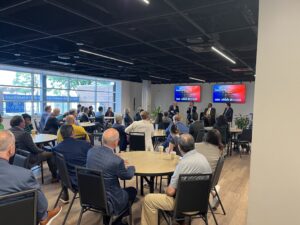Amanda Ellis
If you spend time in downtown Chattanooga, you’ve undoubtedly noticed an influx of new apartment buildings, and you’ve probably noticed some vacant retail and office space as well. Though our area has seen years of growth, development and national recognition, perhaps you wonder if we’ve overbuilt high-end rental housing while neglecting to use available commercial space. Turns out, it’s not that simple, and real estate experts say to be patient.
Aaron White, Principal and Co-Founder of Evergreen Real Estate, a private real estate development company with a portfolio of 2,500 units in Chattanooga, Knoxville, Nashville and other Southeastern cities, owns several apartment communities in the Chattanooga area — including Northshore Village and Vista Cameron Harbor. White says Northshore Village is 99 percent occupied with Vista Cameron Harbor at 97 percent. Northshore Village floor plans range from $780 to $1,200 monthly, while Vista’s start at $970 and go up to $1,800. Both are popular with residents.
“The only thing that's changed in Chattanooga is for the first time ever there's a fair amount of apartments downtown,” White says. “But it’s new supply in a small market, so vacancies go up because it’s brand new product and hasn’t had time to get absorbed.”
White speaks to the much-touted positive aspects of our area: state tax structure favorable for both businesses and individuals, reasonable cost of living, close to other major cities, outdoor recreation – the list goes on. People love it here.
“I can't say all that about many other cities, and of the ones I can – Chattanooga is significantly more affordable than they are, and has some of the most desirable real estate in the state.”
White says he’s seeing solid demand for apartments and condos. Evergreen built more than 100 over the summer, and more than half have sold.
“While I'm not going to go build three new apartment products in Chattanooga right now, I'm not at all nervous about what is being built today. It's a healthy market. I can't say it's perfectly at equilibrium, but it's not crazy. It doesn't scare me.”
He also references the national trend of migrating to urban areas and other cities that have seen building projects surge all at once.
“Knoxville had a recent wave of building too. People sold stuff. I sold a deal, and the apartment complex had to offer incentives for a bit. But when the market stabilized, renters were used to paying more. The group that bought it was eventually renting units for more than when I owned it.”
While that sounds great for developers, what about renters? For renters, high-wage jobs with growth potential are vital. We must generate jobs and the competition from other communities can be intense. The Chattanooga Chamber of Commerce economic development team, the Chattanooga Airport, TVA, EPB, Hamilton County, the City of Chattanooga and other players help us effectively compete and often win, but the availability and the style of the actual physical space is also crucial.
“There is a larger vacancy factor in downtown Class A office space than in years past,” says David DeVaney, President of Chattanooga commercial real estate firm NAI Charter. “One trend I’m seeing is that, due to low interest rates and strong economy, business owners often want to own their building. The submarkets on the periphery of downtown: Main Street, Southside and NorthShore, are strong and vibrant. Building owners who haven’t modernized their properties to attract millennials are the ones most affected. Class A office buildings shouldn’t look like they did 20 years ago.”
What is Class A office space? Office buildings can fall into a few categories: Class A, Class B or Class C. Features of each classification vary by market, but generally Class A represents the best quality — the latest tech, great location, entirely updated. Class B is a step down, perhaps older but still functional. Minor renovations could seriously upgrade these spaces. Class C properties, the lowest tier, require extensive renovation and are the most outdated of the three groups.
DeVaney, a Chattanooga native with 30 years of experience in commercial real estate, points to Liberty Tower, The Volunteer Building and The Edney as examples of properties renovated to create a unique working environment.
“Collaborative space and open floor plans are what people now desire.”
In terms of available land for manufacturing and warehousing, Hamilton County doesn’t have the inventory of surrounding counties, and what it does have is significantly more expensive. Even at the regional level, few large tracts of land are ready for industry, but looking outside of Hamilton County allows for more options. DeVaney says that’s why a regional approach is key. It’s a big reason for the Chamber’s Greater Chattanooga Economic Partnership initiative, which captures the appeal of Hamilton County and 15 surrounding counties. When a company relocates to our region, the economic benefits are not defined by county lines. Google’s $600 million North Alabama data center is a great example.
White mentions the important of solid workforce development efforts as well. Our community’s growth in this area ranges from Hamilton County’s Future Ready Institutes and Chattanooga State’s paid apprenticeship programs, both introduced in 2018, to excellent traditional higher education.
“Our thriving, four-year university (UTC) consistently draws talented students, continuing to add to the educated workforce,” White says. “That's what a growing city needs. And they continue to step up year after year. Test scores, student population, quality of research, quality of athletics – it’s all rising.”
UTC served as a big driver for Chris Curtis and his company Riverside Development to create Douglas Heights, an upscale student apartment complex on Martin Luther King Blvd. He’s from Chattanooga and passionate about the MLK district.
“We’re committed to building MLK — mixed use and more restaurants, service businesses and offices, but I don't want to build too fast,” Curtis says. “We want to build smaller projects, grow the business, foot traffic and keep building those blocks out in stages versus doing all at one time. It’s a process.”
Curtis predicts a heavier concentration of 25- to 35-year-olds locating there as the area grows.
“There’s opportunity for us to be the ‘live and play’ side of their work environment, so we need to have housing and services available. You can’t draw new workforce if there's nowhere to live. Once you’ve built, you drive business to follow those heads and beds.”
Curtis believes Chattanooga’s new rental units will be absorbed in time. In fact, he’ll be surprised if it’s not within the year.
“I think we're trying to figure out the balance of downtown right now and what's viable, but you can't get paralyzed. You strive for incremental wins. If you wait for the home run, you might still be sitting there in ten years.”
Images in this post depict Vista Cameron Harbor







